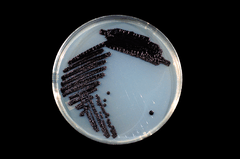Janthinobacterium lividum
| Janthinobacterium lividum | |
|---|---|
 | |
| Scientific classification | |
| Kingdom: | Bacteria |
| Phylum: | Proteobacteria |
| Class: | Betaproteobacteria |
| Order: | Burkholderiales |
| Family: | Oxalobacteraceae |
| Genus: | Janthinobacterium |
| Species: | J. lividum |
| Binomial name | |
| Janthinobacterium lividum (Eisenberg 1891) De Ley et al. 1978 (Approved Lists 1980) | |
| Type strain | |
| ATCC 12473 CCUG 2344 CIP 103349 DSM 1522 HAMBI 1919 JCM 9043 LMG 2892 NCTC 9796 VKM B-1223 | |
| Synonyms | |
|
Bacillus lividus Eisenberg 1891 | |
Janthinobacterium lividum is an aerobic, gram-negative, soil-dwelling bacterium that has a distinctive dark-violet (almost black) color. This color is due to a compound called violacein, which is produced when glycerol is metabolized as a carbon source. Violacein has anti-bacterial, anti-viral, and anti-fungal properties. Its anti-fungal properties are of particular interest since J. lividum is found on the skin of certain amphibians, including the red-backed salamander (Plethodon cinereus), where it prevents infection by the devastating chytrid fungus (Batrachochytrium dendrobatidis).[2]
Etymology
The genus name, Janthinobacterium, comes from Latin janthinus, which means "violet" or "violet-blue" + bacterium, which means rod or staff.[3] The species name is also from Latin, lividum, which means "of a blue or leaden color".[4]
Antifungal properties
This bacterium produces antifungal compounds, such as indole-3-carboxaldehyde and violacein.[5]
Resistance to Batrachochytium dendrobatidis
J. lividum inhibits the toxic effect and growth of a fungus known as Batrachochytrium. This fungus causes a disease known as Chytridiomycosis in amphibians and is contributing to the massive declines of amphibians around the world so understanding the uses of this bacteria has been of major interest.
A study conducted in 2009 explored the effects of Bd and the use of J. lividium in the lab for survival. They used three experimental treatments: frogs infected with Bd, frogs given the bacteria J. lividium and frogs with the given bacteria and then exposed to Bd. Nearly all of the frogs exposed to Bd experienced mortality while none of the other treatments had any deaths. This effectively introduced the use of J. lividium as a possible method for Bd prevention in the lab setting.[6]
References
- ↑ Kämpfer, P., Falsen, E., and Busse, H. J. (2008) "Reclassification of Pseudomonas mephitica Claydon and Hammer 1939 as a later heterotypic synonym of Janthinobacterium lividum (Eisenberg 1891) De Ley et al. 1978." Int. J. Syst. Evol. Microbiol., 58:136–138. doi:10.1099/ijs.0.65450-0 PMID 18175698
- ↑ Small Things Considered: What You Don't Know About Janthinobacterium
- ↑ http://www.bacterio.cict.fr/ijk/janthinobacterium.html
- ↑ Ibid.
- ↑ Brucker, Robert M.; Harris, Reid N.; Schwantes, Christian R.; Gallaher, Thomas N.; Flaherty, Devon C.; Lam, Brianna A.; Minbiole, Kevin P. C. (2008-11-01). "Amphibian chemical defense: antifungal metabolites of the microsymbiont Janthinobacterium lividum on the salamander Plethodon cinereus". Journal of Chemical Ecology. 34 (11): 1422–1429. doi:10.1007/s10886-008-9555-7. ISSN 0098-0331. PMID 18949519.
- ↑ Harris, Reid N.; Brucker, Robert M.; Walke, Jenifer B.; Becker, Matthew H.; Schwantes, Christian R.; Flaherty, Devon C.; Lam, Brianna A.; Woodhams, Douglas C.; Briggs, Cheryl J. (2009-07-01). "Skin microbes on frogs prevent morbidity and mortality caused by a lethal skin fungus". The ISME journal. 3 (7): 818–824. doi:10.1038/ismej.2009.27. ISSN 1751-7370. PMID 19322245.